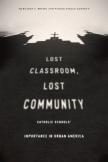The Costs of Closings
University Of Chicago Press. 224p $45
In the last two decades, 1,600 Catholic schools have closed. The Archdiocese of Philadelphia, for example, closed 48 schools in 2012. Similar steep statistics on Catholic school closures can be found for other dioceses, including Detroit, Chicago and Indianapolis. The number of students attending Catholic schools has decreased from a high of 5.2 million students in the late 1960s to only 2.1 million today. Many of these school closures have been of inner-city Catholic schools that served minority racial populations.
We have long known, since the pioneering work of James Coleman, that minority students in Catholic schools score higher on standardized achievement tests and are more likely to attend and graduate from college than their public school counterparts, regardless of their family’s educational or financial background. As Nicholas Lemann observed in The Atlantic Monthly in 1986: “ In the ghetto today, the only institutions with a record of consistently getting people out of the underclass are the parochial schools.”
Brinig and Garnett are intent on showing that it is not just the inner social capital of Catholic schools (discipline, parental involvement, teacher dedication) that counts but that this social capital has a spillover effect on neighborhoods. Using data from Chicago, they compare the crime rates and other disorderly behavior in police beats where Catholic schools have closed (Chicago closed 63 of its 225 neighborhood schools between 1984 and 1994) to police beats where the Catholic schools remained open. They show, for example, a pastor-effect on school closing. Schools were more likely to close if there was just an administrator rather than a long time pastor, or if there was a new pastor. But the crime rate in neighborhoods where Catholic schools remained open was 33 percent lower than in similar neighborhood police beats where Catholic schools had closed. They are looking at Catholic schools not only as educational institutions but as civic or community institutions. As one commentator noted: “flourishing inner-city Catholic schools make for flourishing inner-city neighborhoods. We’ll sorely miss them when they are gone!”
Because of a peculiarity of the decision to found Catholic schools at the parish level, Catholic schools are often more neighborhood schools than the nearby public schools. Given the widespread move to allow greater school choice in public schools, many draw large numbers of students from other neighborhoods. The authors do a very careful statistical analysis using data on Chicago neighborhoods and crime data to argue that Catholic schools generate civic and neighborhood social capital. Closing inner-city Catholic schools, then, not only lessens educational opportunity for minorities but has an effect on neighborhood cohesion and crime. The authors draw on similar data for Philadelphia and Los Angeles.
Given the general failure of inner-city public schools, many school districts have turned to charter schools. At first, charter schools might look like competition to Catholic schools. As Dianne Ravitch once put it: “Where Charter schools are expanding, Catholic schools are dying.”
Data on the success of charter schools is quite mixed. While charter schools in Chicago, for example, seem to outperform noncharter public schools, this is not true in Washington, D.C. Moreover, many abandoned Catholic schools lease their building to a charter school. For example, 90 percent of closed Detroit Catholic schools are now charter schools. In Miami, Washington and Indianapolis also, many closed Catholic schools are now charter schools. But the authors marshal data to show that charter schools do not at all have the same social capital spillover effect on their neighborhoods. Indeed, the data show that in Chicago crime has risen in charter school inner-city neighborhoods.
The authors review the arguments for and against schemes that allow school choice—tuition tax credits for private schools, for example, or a voucher system for parental choice of schools. (This is constitutionally allowed, since the aid goes to the parents, who then have a choice of where to spend it rather than directly to the school from the government.) They also marshal evidence that shows that “Catholic school students exhibit a greater understanding of democratic principles, more civic knowledge, higher levels of community engagement and a greater tolerance for diversity than public schools.” Discipline inside the classroom may lead to greater discipline outside of it.
Lost Classroom, Lost Opportunity, a seminal and well-written book, as Michael Sean Winters put it, should become “a ‘must read’ for every bishop, every school superintendent and every director of a state Catholic conference, as well as for anyone, Catholic or not, who cares about bringing relief to the often miserable conditions that confront urban America.”
This article also appeared in print, under the headline “The Costs of Closings,” in the July 6-13, 2015, issue.








